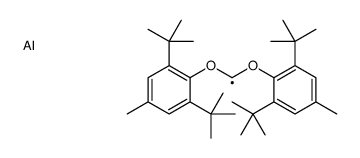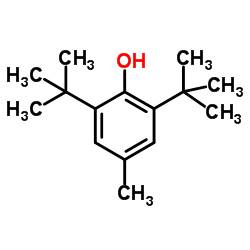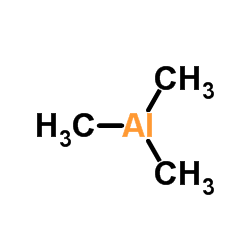Bis(2,6-di-Tert-Butyl-4-Methylphenoxy)Methylaluminum
Modify Date: 2025-08-26 12:00:56

Bis(2,6-di-Tert-Butyl-4-Methylphenoxy)Methylaluminum structure
|
Common Name | Bis(2,6-di-Tert-Butyl-4-Methylphenoxy)Methylaluminum | ||
|---|---|---|---|---|
| CAS Number | 56252-55-2 | Molecular Weight | 478.68500 | |
| Density | 0.94 | Boiling Point | N/A | |
| Molecular Formula | C31H47AlO2 | Melting Point | N/A | |
| MSDS | N/A | Flash Point | N/A | |
| Name | Bis(2,6-di-Tert-Butyl-4-Methylphenoxy)Methylaluminum |
|---|---|
| Synonym | More Synonyms |
| Density | 0.94 |
|---|---|
| Molecular Formula | C31H47AlO2 |
| Molecular Weight | 478.68500 |
| Exact Mass | 478.33900 |
| PSA | 18.46000 |
| LogP | 8.78410 |
|
Section I.Chemical Product and Company Identification Chemical NameMethylaluminum Bis(2,6-di-tert-butyl-4-methylphenoxide), (0.4 mol/L Toluene Solution) Portland OR SynonymBis (2,6-di-tert-butyl-4-methylphenoxy)methylaluminum, (0.4 mol/L Toluene Solution)
C31H49AlO2 Chemical Formula CAS Number56252-55-2 (Toluene) 108-88-3 Section II.Composition and Information on Ingredients Chemical NameCAS Number Percent (%)TLV/PELToxicology Data Methylaluminum Bis(2,6-di-tert-butyl-4-methylphenoxide),56252-55-2ca. 22%This chemical is classified as (Toluene) (0.4 mol/L Toluene Solution)ca. 78%a possible carcinogen. There Rat LD50 (oral) 636 mg/kg (Toluene) is no acceptable exposure limit Rabbit LD50 (dermal) 14100 uL/kg 108-88-3 Rat LC50 (inhalation) 49 gm/m3/4H for a carcinogen. This compound is classified as a possible mutagen. There is no acceptable exposure limit for a mutagen. Section III. Hazards Identification Irritating to eyes and skin on contact. Inhalation causes irritation of the lungs and respiratory system. Inflammation of the Acute Health Effects eye is characterized by redness, watering, and itching. Skin inflammation is characterized by itching, scaling, reddening, or, occasionally, blistering. Toxic if ingested or inhaled. Avoid prolonged contact with this material. Overexposure may result in serious illness or death. Follow safe industrial hygiene practices and always wear proper protective equipment when handling this compound. CARCINOGENIC EFFECTS : Not available. Chronic Health Effects MUTAGENIC EFFECTS : Not available. TERATOGENIC EFFECTS : Not available. DEVELOPMENTAL TOXICITY: Reproductive Effects. (Toluene) Rat TCLo Inhalation 800 mg/m3/6 hours female 14-20 days of pregnancy. TOXIC Effects: Effects on Embryo or Fetus - Fetotoxicity. Effects on Newborn - Behavioral. Mouse TCLo Inhalation 400 ppm/7 hours female 7-16 days of pregnancy. TOXIC Effects: Specific Developmental Abnormalities - Musculoskeletal system. Effects on Newborn - Biochemical and metabolic. Mouse TDLo Oral 9 gm/kg female 6-15 days of pregnancy. TOXIC Effects: Effects on Embryo or Fetus - Fetal death. Repeated exposure to an highly toxic material may produce general deterioration of health by an accumulation in one or many human organs. Continued on Next Page Methylaluminum Bis(2,6-di-tert-butyl-4-methylphenoxide), (0.4 mol/L Toluene Solution) Section IV.First Aid Measures Eye ContactCheck for and remove any contact lenses. In case of contact, immediately flush eyes with plenty of water for at least 15 minutes. Get medical attention. Skin ContactIn case of contact, immediately flush skin with plenty of water for at least 15 minutes while removing contaminated clothing and shoes. Wash clothing before reuse. Thoroughly clean shoes before reuse. Get medical attention immediately. InhalationIf the victim is not breathing, perform mouth-to-mouth resuscitation. Loosen tight clothing such as a collar, tie, belt or waistband. If breathing is difficult, oxygen can be administered. Seek medical attention if respiration problems do not improve. IngestionINDUCE VOMITING by sticking finger in throat. Lower the head so that the vomit will not reenter the mouth and throat. Loosen tight clothing such as a collar, tie, belt or waistband. If the victim is not breathing, perform mouth-to-mouth resuscitation. Examine the lips and mouth to ascertain whether the tissues are damaged, a possible indication that the toxic material was ingested; the absence of such signs, however, is not conclusive. Section V.Fire and Explosion Data (Toluene) Flammable.Auto-Ignition Flammability 535°C (995°F) Flammable Limits Flash Points(Toluene) 5°C (41°F). LOWER: 1.2% UPPER: 7% (Toluene) 4°C (39.2°F). Combustion ProductsThese products are toxic carbon oxides (CO, CO2), metallic oxides. Fire Hazards Not available. Risks of explosion of the product in presence of mechanical impact: Not available. Explosion Hazards Risks of explosion of the product in presence of static discharge: Not available. Fire Fighting MediaFlammable liquid. and InstructionsDO NOT use water. SMALL FIRE: Use DRY chemical powder. LARGE FIRE: Use alcohol foam, or dry chemical powder. Consult with local fire authorities before attempting large scale fire-fighting operations. Section VI.Accidental Release Measures Spill CleanupWater-reactive material. Flammable material. Toxic material. Irritating material. Air sensitive material. Moisture sensitive material. Possible carcinogenic material. Mutagenic material. Neurological hazard. Instructions Keep away from heat. Mechanical exhaust required. Stop leak if without risk. Absorb with DRY earth, sand or other non-combustible material. DO NOT get water inside container. DO NOT touch spilled material. Use water spray to reduce vapors. Prevent entry into sewers, basements or confined areas; dike if needed. Consult federal, state, and/or local authorities for assistance on disposal. Section VII. Handling and Storage Handling and StorageWATER-REACTIVE. FLAMMABLE LIQUID. TOXIC. IRRITANT. AIR SENSITIVE. MOISTURE SENSITIVE. POSSIBLE CARCINOGEN. POSSIBLE MUTAGEN. NEUROLOGICAL HAZARD. STORE UNDER NITROGEN. REFRIGERATE. Information Keep locked up. Keep under inert atmosphere. Keep container dry. DO NOT ingest. Do not breathe gas/fumes/ vapor/spray. Never add water to this product. Wear suitable protective clothing. If ingested, seek medical advice immediately and show the container or the label. Treat symptomatically and supportively. Always store away from incompatible compounds such as oxidizing agents, metals, acids, alkalis (bases). Section VIII. Exposure Controls/Personal Protection Engineering ControlsProvide exhaust ventilation or other engineering controls to keep the airborne concentrations of vapors below their respective threshold limit value. Ensure that eyewash station and safety shower is proximal to the work-station location. Personal ProtectionSplash goggles. Lab coat. Vapor respirator. Boots. Gloves. A MSHA/NIOSH approved respirator must be used to avoid inhalation of the product. Suggested protective clothing might not be sufficient; consult a specialist BEFORE handling this product. Exposure LimitsThis chemical is classified as a possible carcinogen. There is no acceptable exposure limit for a carcinogen. This compound is classified as a possible mutagen. There is no acceptable exposure limit for a mutagen. Section IX. Physical and Chemical Properties Solubility Physical state @ 20°CLiquid. (Light Yellow Clear.)(Toluene) Very slightly soluble in water. 0.89 (water=1)Miscible with alcohol, chloroform, ether, Specific Gravity (Toluene)acetone, glacial acetic acid, carbon 0.865 (water=1)disulfide. Molecular Weight480.7Partition Coefficient(Toluene) (Toluene)Log Kow: 2.73 92.14 Boiling Point(Toluene)Vapor Pressure(Toluene) 110.6°C (231.1°F)28.4 mmHg (@ 25°C) Continued on Next Page Methylaluminum Bis(2,6-di-tert-butyl-4-methylphenoxide), (0.4 mol/L Toluene Solution) Melting Point(Toluene)Vapor Density(Toluene) -93°C (-135.4°F)3.1 (Air = 1) Refractive Index(Toluene)VolatilityNot available. 1.496-1.498 Critical TemperatureNot available.OdorNot available. Viscosity(Toluene)TasteNot available. 0.778 cP @ 0°C Section X.Stability and Reactivity Data Stability This material is stable if stored under proper conditions. (See Section VII for instructions) Conditions of InstabilityAvoid excessive heat and light. Incompatibilities Reactive with strong oxidizing agents, metals, acids, alkalis (bases), water, alkali metals, aluminum, heat. Section XI. Toxicological Information (Toluene) RTECS Number XS5250000 Routes of ExposureEye Contact. Ingestion. Inhalation. (Toluene) Toxicity Data Rat LD50 (oral) 636 mg/kg Rabbit LD50 (dermal) 14100 uL/kg Rat LC50 (inhalation) 49 gm/m3/4H Chronic Toxic EffectsCARCINOGENIC EFFECTS : Not available. MUTAGENIC EFFECTS : Not available. TERATOGENIC EFFECTS : Not available. DEVELOPMENTAL TOXICITY: Reproductive Effects. (Toluene) Rat TCLo Inhalation 800 mg/m3/6 hours female 14-20 days of pregnancy. TOXIC Effects: Effects on Embryo or Fetus - Fetotoxicity. Effects on Newborn - Behavioral. Mouse TCLo Inhalation 400 ppm/7 hours female 7-16 days of pregnancy. TOXIC Effects: Specific Developmental Abnormalities - Musculoskeletal system. Effects on Newborn - Biochemical and metabolic. Mouse TDLo Oral 9 gm/kg female 6-15 days of pregnancy. TOXIC Effects: Effects on Embryo or Fetus - Fetal death. Repeated exposure to an highly toxic material may produce general deterioration of health by an accumulation in one or many human organs. Irritating to eyes and skin on contact. Inhalation causes irritation of the lungs and respiratory system. Inflammation of the Acute Toxic Effects eye is characterized by redness, watering, and itching. Skin inflammation is characterized by itching, scaling, reddening, or, occasionally, blistering. Toxic if ingested or inhaled. Avoid prolonged contact with this material. Overexposure may result in serious illness or death. Follow safe industrial hygiene practices and always wear proper protective equipment when handling this compound. Section XII.Ecological Information EcotoxicityNot available. Environmental Fate(Toluene) Toluene is released into the atmosphere principally from the volatilization of petroleum fuels and toluene-based solvents and thinners and from motor vehicle exhaust. Toluene's production and use as an intermediate in the production of benzoic acid, benzaldehyde, benzene, explosives, dyes and many other organic compounds may also result in its release to the environment through various waste streams. Toluene has been detected in emissions from volcanos, forest fires and crude oil. If released to air, a vapor pressure of 28.4 mm Hg at 25 deg C indicates toluene will exist solely as a vapor in the ambient atmosphere. Vapor-phase toluene will be degraded in the atmosphere by reaction with photochemically-produced hydroxyl radicals; the half-life for this reaction in air is estimated to be 3 days. Toluene may also be degraded in the atmosphere by reaction with nitrate radicals and ozone molecules, but these reactions are too slow to be environmentally important. If released to soil, toluene is expected to have high to moderate mobility based upon Koc values in the range of 37-178. Volatilization from moist soil surfaces is expected to be an important fate process based upon a Henry's Law constant of 6.64X10-3 atm-cu m/mole. Toluene may volatilize from dry soil surfaces based upon its vapor pressure. Biodegradation is expected to occur rapidly in soil surfaces, with half-lives in the range of several hours to 71 days. If released into water, toluene is not expected to adsorb to suspended solids and sediment based upon a Koc of 166 measured in lake sediment. Biodegradation is expected to occur rapidly in water, with reported half-lives of 4 and 56 days in aerobic and anaerobic water, respectively. Volatilization from water surfaces is expected to be an important fate process based upon this compound's Henry's Law constant. Estimated volatilization half-lives for a model river and model lake are 1 hour and 4 days, respectively. Measured BCF values of 13 and 90 in fish suggest bioconcentration in aquatic organisms is low to moderate. Hydrolysis is not expected to be an important environmental fate process for toluene due to lack of hydrolyzable functional groups. Exposure to toluene may occur occupationally during its production or subsequent use, particularly as a solvent or in gasoline, via dermal and respiratory routes. The main route of exposure for the general population will be through inhalation from contaminated air and handling of gasoline as well as ingestion of contaminated drinking water and food, and exposure to some consumer products. Continued on Next Page Methylaluminum Bis(2,6-di-tert-butyl-4-methylphenoxide), (0.4 mol/L Toluene Solution) Section XIII.Disposal Considerations Recycle to process, if possible. Consult your local regional authorities. You may be able to dissolve or mix material with a Waste Disposal combustible solvent and burn in a chemical incinerator equipped with an afterburner and scrubber system. Observe all federal, state and local regulations when disposing of the substance. Section XIV. Transport Information DOT ClassificationDOT Class 4.3: Dangerous when wet material. DOT Class 3: Flammable liquid. PIN Number Proper Shipping NameOrganometallic substance, liquid, water-reactive, flammable. Packing Group (PG)II DOT Pictograms DANGEROUSW HEN W ET 4 Section XV. Other Regulatory Information and Pictograms TSCA Chemical InventoryThis product is NOT on the EPA Toxic Substances Control Act (TSCA) inventory. The following notices are required by 40 CFR 720.36 (C) for those products not on the inventory list: (EPA) (i) These products are supplied solely for use in research and development by or under the supervision of a technically qualified individual as defined in 40 CFR 720.0 et sec. (ii) The health risks of these products have not been fully determined. Any information that is or becomes available will be supplied on an MSDS sheet. (Toluene) This compound is ON the EPA Toxic Substances Control Act (TSCA) inventory list. WHMIS ClassificationCLASS B-2: Flammable liquid with a flash point lower than 37.8°C (100°F). CLASS D-1B: Material causing immediate and serious toxic effects (TOXIC). (Canada) (Toluene) On DSL. EINECS Number (EEC)(Toluene) 203-625-9 EEC Risk StatementsR10- Flammable. R14- Reacts violently with water. R18- In use, may form flammable/explosive vapor-air mixture. R23/24/25- Toxic by inhalation, in contact with skin and if swallowed. R36/37/38- Irritating to eyes, respiratory system and skin. R45- May cause cancer. R46- May cause heritable genetic damage. R47- May cause birth defects. Japanese Regulatory Data (Toluene) SECTION 16 - ADDITIONAL INFORMATION N/A |
| Risk Phrases | 11-34 |
|---|---|
| Safety Phrases | 3/7-9-16-26-36/37/39-45 |
| RIDADR | UN 2924 |
|
~98% 
Bis(2,6-di-Tert... CAS#:56252-55-2 |
| Literature: Stapleton, Russell A.; Al-Humydi, Abdulaziz; Chai, Jianfang; Galan, Brandon R.; Collins, Scott Organometallics, 2006 , vol. 25, # 21 p. 5083 - 5092 |
| Precursor 2 | |
|---|---|
| DownStream 0 | |
| bis(2,6-ditert-butyl-4-methylphenoxy)methylaluminum |

